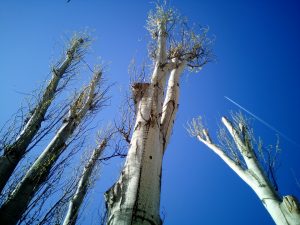 Myths arise in almost every subject area, and trees are no different. Unfortunately, belief in these myths can lead homeowners (and unqualified tree workers) to make mistakes in the process of caring for trees. To help ensure you don’t fall victim to some of these myths, we’ve outlined six of the most common below.
Myths arise in almost every subject area, and trees are no different. Unfortunately, belief in these myths can lead homeowners (and unqualified tree workers) to make mistakes in the process of caring for trees. To help ensure you don’t fall victim to some of these myths, we’ve outlined six of the most common below.
- A Tree’s Roots Mirror the Canopy
Many people envision a tree’s roots penetrating the soil in a manner similar to the tree’s canopy, but this is not correct. Aside from a central taproot and a relatively small number of roots directly under the tree, the vast majority of a tree’s roots extend laterally. Many extend beyond the canopy’s drip line, and most are located in the upper 24 inches of soil.
- Branch Stubs Must Be Painted
Historically, tree-care professionals would apply a specially formulated paint on the freshly cut surface exposed during pruning activities. The idea behind the practice was that the paint would protect the exposed wood from fungi and pathogens. However, research has shown that this is not only unnecessary, it reduces the rate at which the tree can compartmentalize the wound, and it can trap fungal spores underneath the paint.
- Tree Wounds Heal Over Time
When an animal suffers a wound, its body replaces the cells near the wound as well as any that were lost in the accident. However, trees do not heal in this fashion; in fact, trees do not heal at all. Instead, trees essentially encapsulate wounds with new tissue and go right on with their lives.
- Topping Is a Good Way to Reduce a Tree’s Height
There aren’t many good ways to reduce a tree’s height, and topping (the practice of cutting a tree’s central leader at an arbitrary point) is one of the worst. The best option is a technique called crown reduction, which seeks to make proper pruning cuts at strategic places in the canopy, to reduce its size. Crown reductions are difficult to carry out and require the experienced eye of a skilled arborist.
- Trees Should Be Pruned Immediately Following Planting
The rationale behind pruning a tree at the time of planting is that by reducing the number of leaves present, you can decrease the water requirements of the tree during the initial installation period. However, trees establish themselves most quickly by producing new root growth. To accomplish this, the tree needs to produce plenty of food, which can then be converted into new root tissue. And to produce food, a tree needs its leaves. While structural pruning should be carried out around the time of installation, this typically removes a relatively small number of leaves.
- Mulch Should Be Placed Around a Tree’s Trunk
Properly applied, a thick layer of mulch can protect and help nourish a tree’s roots. However, if mulch is allowed to pile up around the base of a tree’s trunk, it can trap moisture, fungi and insects, which can lead to serious problems and eventual failure. Instead, place mulch over the root system, but scrape all mulch away from the base of the tree to create a small “donut hole” around the trunk.
It can be easy to mistake myths for facts, particularly when you’ve got so many other things in life that require your attention. You probably don’t have the time to research and verify everything you hear about trees. But that’s where we come in: Our experienced arborists have the skills, training and education to understand the truth about trees and the best way to care for them.
If you have a question or conundrum about your trees, give your favorite arborists a call. We’re happy to help.
